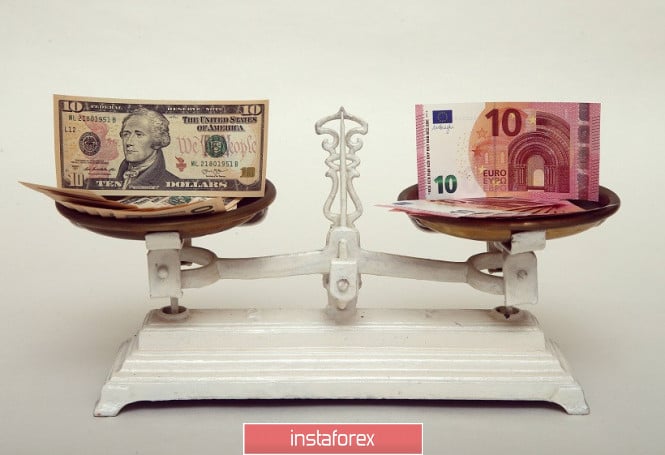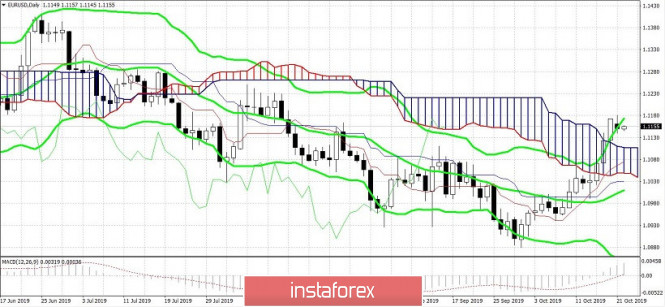The euro-dollar pair began the trading week rather slurred: the bulls lost momentum to continue the price growth, while the bears cannot return the price even within the 10th figure due to the general weakness of the US currency. As a result, the pair got stuck in a flat, waiting for the key events of this week. The fundamental picture for EUR/USD is currently too controversial, so traders are in no hurry to open large positions - neither buy nor sell.
Both the euro and the dollar are now under the yoke of their problems, so the general weakness of the US currency in this pair is not as pronounced as, say, in the AUD/USD or USD/CAD. Nevertheless, a consistent decline in the dollar index makes it possible for EUR/USD to "stay afloat", despite the fact that the upward momentum for the pair faded even at the beginning of the trading week. The pair's growth at the end of last week was primarily due to Brexit - the euro responds to the main and most important stages of the "divorce proceedings".

But even at the weekend it became clear that Johnson's "blitzkrieg" had failed, and the deputies would not blindly ratify the draft deal in a single burst of solidarity. The Brexit issue moved into a longer-lasting phase, after which this fundamental factor ceased to support the growth of EUR/USD. The current political battles in the UK have an indirect effect on the dynamics of the pair (unlike the GBP/USD pair, where any news regarding the possible prospects of Brexit is still an unconditional priority), so at the moment this topic has faded into the background. But not for long: as soon as Johnson returns to the House of Commons with the necessary bills (in accordance with the requirements of the Letwin amendment), the dynamics of the pound will again affect the general position of the euro - and this will be until Thursday, when the October meeting of the European Central Bank takes place.
But the situation is more complicated with the dollar. Amid the almost empty economic calendar, traders assess the likelihood of a Federal Reserve interest rate cut at the next meeting, building on the latest published releases. In turn, these releases leave much to be desired. Industrial production indicators come out in the red zone, significantly not reaching the forecast values, and in some cases, indicating new multi-year anti-records.
Obviously, this dynamics is primarily due to "military operations" on the front of the trade war between the United States and China. Recent talks between Washington and Beijing have not resolved the overall situation. By and large, the parties just did not allow further escalation of the trade conflict, while the most complex and fundamental issues were not even discussed by the negotiators. Therefore, after a slight surge of optimism regarding the outcome of the 13th round of negotiations, dollar bulls came to the reasonable conclusion that the prospects for the development of a trade war are still vague, while key US macroeconomic indicators (especially in the field of industrial production) are already declining. In other words, the issue of easing monetary policy by the Fed is on the agenda again, especially after the latest signals from the US Treasury Secretary and some Fed officials.
Stephen Mnuchin said last week that Washington would nevertheless introduce additional duties on Chinese goods (which were scheduled for December 15) - if at that time the parties did not sign a trade deal. He, of course, expressed hope for a compromise, but recalled the consequences of the opposite result. Apparently, the fate of the trade deal will be decided in November: over the course of several weeks of the penultimate month of this year, the parties will negotiate at various levels - both within the working group, at the ministerial level, and at the level of senior officials of the states. According to unofficial information, the Chinese side has already expressed its intention to "clarify some points" of the first phase of the deal before proceeding to the second stage. Given this fact, it can be assumed that the parties are facing difficult negotiations, and the probability of a deal by November is quite small.
All this suggests that the Federal Reserve in October can either lower the interest rate or warn the markets about the corresponding intentions that will be realized at the December meeting. In this context, the rhetoric of the Fed representative Richard Clarida looks significant. Yesterday, he negatively assessed the trends in the US economy, and secondly, did not rule out a rate cut already at the October meeting. He said that US inflation remains weak, and economic growth has clearly slowed in the second half of the year. Against the background of such comments, the dollar index continued its downward movement, while the euro-dollar pair continued to drift within the 11th figure.

Thus, in the short term, the prospects for the euro-dollar pair depend on the prospects of Brexit and the outcome of the ECB meeting. If we consider a longer-term time frame, then the US-Chinese trade negotiations and the results of the October meeting of the Fed come to the fore. From a technical point of view, the EUR/USD bulls need to overcome the nearest resistance - the upper line of the Bollinger Bands indicator on the daily chart (which corresponds to the mark of 1.1180) to indicate the priority of the upward direction. The support level is the 1.1010 price (the middle line of Bollinger Bands on the same timeframe). If the bears overcome this target, then the bullish scenario will finally lose its relevance.
The material has been provided by InstaForex Company - www.instaforex.com